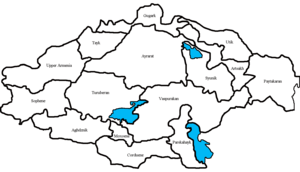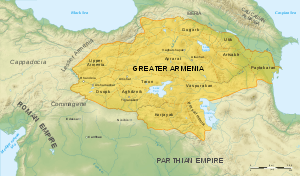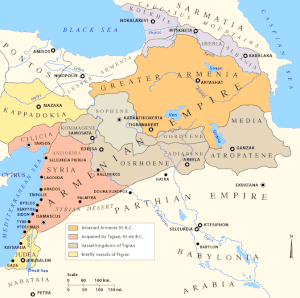Utik
Utik (Armenian: Ուտիք, also known as Uti, Utiq, or Outi) was a historic province of the Kingdom of Armenia and a region of Caucasian Albania after the splitting of Armenia in 387 AD by Sassanid Persia. Most of the region is located within present-day Azerbaijan immediately west of the Kura River while a part of it lies within the Tavush province of present-day northeastern Armenia.
| Utik | |
|---|---|
| Province of Kingdom of Armenia | |
| 189 BC–387 AD | |
 | |
| Capital | Parnes |
| Historical era | Antiquity, Middle Ages |
• Artaxias I declaring himself independent | 189 BC |
| 387 AD | |
| Today part of | |

History
According to Strabo, in the 2nd century BC, Armenians conquered from the Medes the lands of Siwnik and Caspiane, and the lands that lay between them, including Utik,[1] that was populated by the people called Utis, after whom it received its name. Modern historians agree that "Utis" were a people of non-Armenian origin, and the modern ethnic group of Udi is their descendants.[2][3] After the Armenian conquest in the 2nd century BC Utik also had some Armenian population.[4][5][6][7][8] The province was called Otena in Latin sources and Otene in Greek sources.[9]
According to the Armenian geographer Anania Shirakatsi's Ashkharatsuyts ("Geography", 7th century), Utik was the 12th among the 15 provinces of the Kingdom of Armenia, and belonged, at the time, to the Caucasian Albania (when the Utik and Artsakh provinces were lost by Armenia after its partition in the 4th century).[10] According to Ashkharatsuyts, Utik consisted of 8 cantons (gavars, in Armenian): Aranrot, Tri, Rotparsyan, Aghve, Tuskstak (Tavush), Gardman, Shakashen, and Uti. The province was bounded by the Kura River from north-east, river Arax from south-east, and by the province of Artsakh from the west.[11]
Greco-Roman historians from the 2nd century BC to the 4th century AD state that Utik was a province of Armenia, with the Kura River separating Armenia and Albania.[12][13][14] But the Armenian-Albanian boundary along the river Kura, confirmed by Greco-Roman sources, was often overrun by armies of both countries.[15]
According to Strabo, Armenia, which in the 6th century BC had covered a large portion of Asia,[16] had lost some of its lands by the 2nd century BC.[17] At the same time Strabo wrote: "According to report, Armenia, though a small country in earlier times, was enlarged by Artaxias and Zariadris". Around 190 BC, under the king Artashes I, Armenia conquered Vaspurakan and Paytakaran from Media, Acilisene from Cataonia, and Taron from Syria. Some have suggested that Utik was among the provinces conquered by Artashes I at this time,[8] though Strabo doesn't list Utik among Artashes' conquests.[17]
King Urnayr of Caucasian Albania invaded Utik. But in 370 AD, the Armenian sparapet Mushegh Mamikonyan defeated the Albanians, restoring the frontier back to the river Kura.[18] In 387 AD, the Sassanid Empire helped the Albanians to seize from the Kingdom of Armenia a number of provinces, including Utik.[15]
In the middle of the 5th century, by the order of the Persian king Peroz I, the king Vache of Caucasian Albania built in Utik the city initially called Perozapat, and later Partaw and Barda, and made it the capital of Caucasian Albania.[19][20]
Starting with the 13th century, the area covered by Utik and Artsakh was called Karabakh by non-Armenians.
Population
In ancient times, the area was inhabited by "Utis" (modern day Udi people), after whom it was named.[8][21] Early Armenian chronicles (5th century) state that the local princes of Utik descended from the Armenian noble family of Sisakan and spoke Armenian.[22]
Utik had been one of the provinces of Greater Armenia, the population of which is referred to by the name Udini (or Utidorsi) in Latin sources, and by the name Outioi in Greek sources.[7] However, Ancient Greco-Roman writers placed Udis beyond Utik, north of the Kura River.[8]
Pliny the Elder calls "Utis" a Scythian tribe and also mentions so called utidors (which was apparently a tribe of mixed origin). Due to this a drift of ethnonym or more complex ethnogenetic processes are possible (for example, settlement of some Iranian-speaking or, less probably, Finnic peoples and adoption by them of language of the local Caucasian population).[8]
See also
- List of regions of old Armenia
References
- Robert H. Hewsen. "Ethno-History and the Armenian Influence upon the Caucasian Albanians," in: Samuelian, Thomas J. (Hg.), Classical Armenian Culture. Influences and Creativity, Chicago: 1982, 27-40.
- (in Russian) Shnirelman, Viktor A. Memory Wars: Myths, Identity and Politics in Transcaucasia. Moscow: Academkniga, 2003 ISBN 5-94628-118-6, pp. 226-228.
- Hewsen, Robert H. “The Kingdom of Artsakh,” in T. Samuelian & M. Stone, eds. Medieval Armenian Culture. Chico, CA, 1983
- Chahin, Mark. The Kingdom of Armenia: A History. London: RoutledgeCurzon, 2001, p. 181 ISBN 0-7007-1452-9.
- Movses Khorenatsi, "History of Armenia," I.13, II.8
- Movses Kaghankatvatsi, "History of Aghvank," I.4
- "Wolfgang Schulze. The Language of the 'Caucasian Albanian' (Aluan) Palimpses". Archived from the original on 2001-10-30. Retrieved 2001-10-30.
- Igor Kuznetsov. Udis.
- Ptolemy, Geography: Book V, Chapter 13.9
- Anania Shirakatsi. Geography
- Anania Shirakatsi, "Geography"
- Strabo, Geography, 11.14.4, http://www.perseus.tufts.edu/cgi-bin/ptext?doc=Perseus:text:1999.01.0198&loc=11.14.1
- Pliny the Elder, "The Natural history ", 6.39: "..the tribe of Albanians settled on the Caucasian mountains, reaches ... the river Kir making border of Armenia and Iberia"
- Claudius Ptolemy, "Geography" 5.12: "Armenia is located from the north to a part of Colchida, Iberia and Albania along the line, which goes through the river Kir (Kura)"
- Encyclopedia Iranica. M. L. Chaumont. Albania.
- Strabo, Geography, 11.13.5: "In ancient times Greater Armenia ruled the whole of Asia, after it broke up the empire of the Syrians", http://www.perseus.tufts.edu/cgi-bin/ptext?doc=Perseus:text:1999.01.0198&loc=11.13.1
- Strabo, Geography, 11.14.5, http://www.perseus.tufts.edu/cgi-bin/ptext?doc=Perseus:text:1999.01.0198&loc=11.14.1
- Pavstos Buzand, "History of Armenia," 5.13, 4th century AD.
- V. Minorsky, A History of Sharvan and Darband in the 10th-11th centuries, Cambridge (Heffer and Sons), 1958
- Movses Kalankatuatsi. History of Albania
- Agathangelos, History of St. Gregory
- Movses Khorenatsi, "History of Armenia," II.13, II.8
